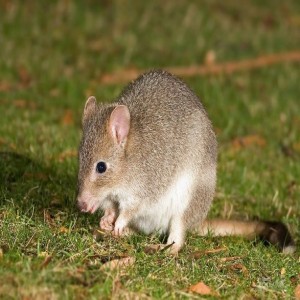 The Bettong, or Brush-tailed Rat Kangaroo, is an extremely rare small marsupial that belongs to the genus Bettongia. It is a small macropod, being only some 30-35 cm in body length, with a tail around 37 cm long, and weighing between 1.1 and 1.6 kg. The fur is yellowish-brown in color with a patch of paler fur on its belly, while the end of its furry tail is dark colored. It has little or no hair on the muzzle and tail. This species has a more slender build and larger ears than its relative the burrowing Bettong.
The Bettong, or Brush-tailed Rat Kangaroo, is an extremely rare small marsupial that belongs to the genus Bettongia. It is a small macropod, being only some 30-35 cm in body length, with a tail around 37 cm long, and weighing between 1.1 and 1.6 kg. The fur is yellowish-brown in color with a patch of paler fur on its belly, while the end of its furry tail is dark colored. It has little or no hair on the muzzle and tail. This species has a more slender build and larger ears than its relative the burrowing Bettong.
Location: Gum Leaf Hideout
Share:
Range
The Bettong once inhabited more than 60% of the Australian mainland, but now occurs on less than 1%. In the 19th century it ranged over all of the SW of Eastern Australia, most of South Australia, the northwest corner of Victoria and across the central portion of New South Wales. By the 1920s, it was extinct over much of its range. As of 1992 it was reported only from four small areas in Western Australia. Through reintroduction of captive bred animals several populations were established. As of 1996, following reintroduction and the controlling of foxes, there were six sites in Western Australia and on three islands and two mainland sites in South Australia.
Habitat
This versatile species is known to once have inhabited a wide range of habitats, including low arid scrub or desert spinifiex grasslands. Today this species lives mostly in open sclerophyll (hard leafed) forest and Malee eucalyptus woodlands with a dense low understory of tussock grasses.
Conservation Status
Critically Endangered
Primary Threats
Human Wildlife Coexistence
Gestation
19-21 days
Litter
Between 1 to 3, but typically only one.
Behavior
They are strictly nocturnal and are not gregarious.
Reproduction
They can breed all year round in favorable conditions. The female can breed at 6 months of age and give birth every 3-5 months.
Wild Diet
In addition to never drinking water, they also refrain from eating green plant material. The brush-tailed Bettong primarily eats fungus, supplementing its diet with bulbs, seeds, insects and resin.
Zoo Diet

